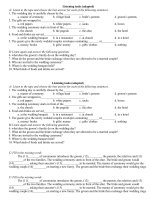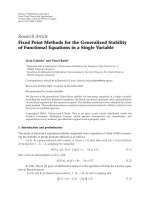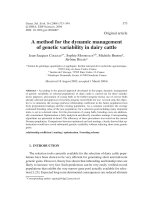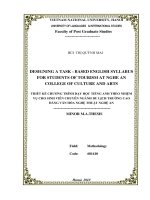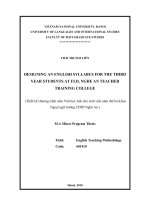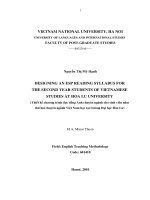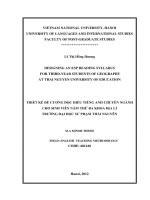Designing text-based tasks for the third-year students of Navigation faculty in Vietnam Maritime University = Thiết kế các nhiệm vụ học tập dựa trên bài khóa ch20150227
Bạn đang xem bản rút gọn của tài liệu. Xem và tải ngay bản đầy đủ của tài liệu tại đây (3.58 MB, 77 trang )
4
TABLE OF CONTENTS
CONTENTS PAGE
Declaration i
Acknowledgement ii
Abstract iii
List of tables and figures viii
List of abbreviations ix
PART A: INTRODUCTION
1. Rationale of the study 1
2. Aims and objectives of the study 3
3. Scope of the study 3
4. Methods of the study 4
5. Significance of the study 4
6. Overview of the study 5
PART B: DEVELOPMENT
CHAPTER 1: LITERATURE REVIEW
1. Defining tasks 6
2. Types of tasks 8
3. Task-based framework 10
4. Text-based tasks 12
4.1. Defining texts in language teaching 12
4.2. Tasks based on texts 12
4.3. Designing text-based task 13
5
5. Considerations in task design 13
6. Using texts in the teaching of English for Specific Purpose 15
7. Summary 16
CHAPTER 2: METHODOLOGY
1. Background of the study 17
1.1. Current learning and teaching of English in general and ESP
in particular at Vietnam Maritime University 17
1.2. Identification of the problem 17
2. Research questions 19
3. Participants 19
4. Implementation of the action research 20
5. Data collection procedures 21
5.1. Description of the pre-treatment questionnaire 21
5.2. Description of the pre-treatment interview 22
5.3. Description of the students’ diary 22
5.4. Description of the post – treatment questionnaire 23
5.5. Description of the post – treatment interview 24
6. Data analysis procedures 24
7. Summary 24
CHAPTER 3: RESULTS AND DISCUSSION
1. Phase One: Conducting pre-treatment questionnaire survey and interview 25
1.1. The results of the pre-treatment questionnaire survey 25
1.1.1. Students’ needs 25
6
1.1.2. The ESP course 26
1.2. The results of the pre-treatment interview 30
2. Phase Two: Conducting the trial lessons 32
2.1. The implementation of the trial lessons 32
2.2. The results of the students’ diary 32
3. Phase Three: Conducting post-treatment questionnaire survey and interview 33
3.1. The results of the post-treatment questionnaire survey 33
3.1.1. Students’ motivations 33
3.1.2. Language skill development 33
3.1.3. The trial lessons’ sequence 34
3.2. The results of the post-treatment interview 37
4. Summary 38
PART 3: CONCLUSION
1. Summary and conclusions 39
2. Pedagogical implications 40
3. Limitations of the study and suggestions for further study 41
REFERENCES 43
APPENDICES
Appendix 1: A sample unit in the course book “Business English for Seamen” I
Appendix 2: A sample lesson plan IV
Appendix 3: Two samples of students’ diaries XIII
Appendix 4: Pre-treatment questionnaire survey (English version) XV
7
Appendix 5: Pre-treatment questionnaire survey (Vietnamese version) XVIII
Appendix 6: Post-treatment questionnaire survey (English version) XXI
Appendix 7: Post-treatment questionnaire survey (Vietnamese version) XXIV
List of tables and figures
Tables
Page
Table 1: A framework for designing task-based lesson by Ellis (2003)
11
8
Table 2: Participants’ information
20
Table 3: Students’ assessments on the themes in the current ESP course book
26
Table 4: Why students like the pre-task cycle
35
Table 5: Why students like the task cycle
36
Table 6: Why students like the post-task cycle
37
Figures
Page
Figure 1: Task-based framework by Willis (1996)
11
Figure 2: Components for analyzing tasks by Nunan (1989)
14
Figure 3: How the current ESP course meets the students’ needs
25
Figure 4: Percentage of students expressing their needs to the teachers
26
Figure 5: Skills students want to learn more
26
Figure 6: Students’ assessments on the activities in the course book
28
Figure 7: Activities that ESP teachers often use
28
Figure 8: Classroom management in current ESP lessons
29
Figure 9: Frequency of using supplementary materials in current ESP lessons
29
Figure 10: Sources of materials
30
Figure 11: Students’ assessments on the trial lessons
33
Figure 12: Skills students have improved through the trial lessons
34
Figure 13: Frequency of skill integration
34
Figure 14: Activities students like doing in pre-task phase
35
Figure 15: Activities students like doing in during-task phase
36
Figure 16: Activities students like doing in post-task phase
37
List of abbreviations
GE: General English
9
ESP: English for Specific Purpose
Vimaru: Vietnam Maritime University
PART A: INTRODUCTION
1. Rationale of the study
Focus on English for seafarers
In the world of international transport and shipping, English is chosen to be the
language for achieving effective ship-to-ship and ship-to-shore communication. The use of
10
English language is becoming a mandatory requirement for many categories of seafarers.
An adequate standard of English is not only an international requirement for the certificate
of seafarers but also a key element in ensuring safe, efficient and profitable ship operation.
Recent amendments to the Safety of Life at Sea convention or SOLAS underline the
need for a common working language in the interest of safety at sea. Unless the personnel
involved speak another common language, English must now be used as the working
language for bridge-to-bridge and bridge-to-shore safety communications, and
communications on board between the pilot and bridge watch-keeping personnel. Officers
of the navigational watch now require adequate knowledge of written and spoken English
to understand charts, nautical publications, meteorological information and messages
concerning the ship’s safety and operation. Seafarers must now demonstrate a knowledge
of English adequate for professional and safety purposes
Although many seafarers bring some understanding of maritime English to the
workplace, their language skills may not be sufficient for communicating instructions and
commands. This deficiency is most apparent among multi-national crews in emergency
situations when language accuracy is critical. The International Maritime Human Element
Bulletin (Issue No. 14 May 2007) asserts that:
The ability to properly convey information by word of mouth and/or by written
communication is important not only to the safety of ships’ crews, visitors and
passengers, but also to the wellbeing of crews. It would seem that the standard of
English of some seafarers is so bad that they have difficulty communicating not
only between themselves but also with agencies outside the ship (p.5)
Teaching English for seafarers
Teaching English for seafarers is by no means an easy task. The maritime world, like
many specialized areas of activity, has language of its own. Some of the words and phrases
are unlikely to mean anything outside this specific area, or if the words are understood
literally, the reader will gain a wrong and possibly odd understanding. Some typical
examples may be: forward spring – a kind of mooring rope, a gypsy – part of the windlass,
monkey island – on top of the wheelhouse. Thus, the teaching of English to seafarers, first
and foremost, must be focused on the teaching of technical vocabulary used commonly for
the job at sea and in nautical publications.
11
However, mastering the words only is not enough. The work of a seafarer, unlike the
work of an architect whose job mainly centers on the silent reading of technical drawings,
requires a great deal of oral interactions. Once communication at sea fails, disastrous
accidents may occur. “The core of the communication failures was found to be lack of
skills in use of maritime English by seafarers of various types and ranks” (Ziarati, Calbas
& Imla, 2008). Therefore, it is also an urgent need for the teaching of English for seafarers
to concentrate on speaking skill and listening skill as well.
All things considered, a nautical student before going to sea must be equipped with a
comprehensive knowledge of English which enables him to communicate successfully at
sea for the sake of safety. Arising from this demand, teaching English for seafarers is hard
work, requiring from teachers much energy, passion and enthusiasm.
1.3. The currently-used ESP course book at the Navigation Faculty of Vietnam Maritime
University
The course book in use for teaching English to the third-year students of
Navigation Faculty in Vietnam Maritime University is named “Business English for
Seafarers”. This book was written in the 1970s by V.I Brobski. It consists of 13 units
which are taught in two semesters. Each unit is concerned with one theme familiar with
sailors’ actual job. Every unit includes a text on the topic and some related exercises
followed.
In my humble opinion, the themes and the texts in this book are practical and suitable
to the students’ major. The problem is that they only focus on developing reading skill, not
to mention that reading activities are few, repeated and simple. The text-based activities
are typically “Answer the following questions on the text” or “Translating the text into your
own language”. It does not at all offer communicative tasks in which students can improve
their four integrated language skills.
Beside this main textbook, teachers are encouraged to use other supplementary
materials. Another matter arises. Almost all ESP materials exist in the form of texts.
Consequently, the teachers will go into the same boring track, asking student to read,
translate and answer the questions. Hardly any teachers have the habit of thinking new
ways to provide students with comprehensive skills. This is not because the teachers are
incapable or lazy but mainly because they are not guided how to devise interesting tasks to
motivate students basing on the available texts. Many shipping companies which are the
12
potential employers of the nautical students often complain about the inability of the
graduates to communicate successfully with the foreign ships at sea and business partners
in international ports though they can read documents quite well.
Inspired by all the aforementioned reasons, I am highly motivated to conduct this
thesis “Designing text-based tasks for the third-year students of Navigation Faculty in
Vietnam Maritime University”.
2. Aims of the study
The study is conducted to:
identify navigation students’ attitudes and viewpoints towards the current ESP
course.
find out what the nautical students expect to learn in the ESP course and how they
want to do it.
suggest effective ways to design different tasks basing on the available texts in the
course book to meet students’ demand, helping teachers select, adapt or create their
own design of effective communicative tasks and make their college English
teaching more successful.
3. Scope of the study
As the title of the thesis implies, this research only focuses on the field of ESP
teaching, not on general English teaching. The participants of the study will be the students
from Navigation faculty of Vietnam Maritime University. Moreover, since the nautical
students do not learn ESP until they come to the third year at university, only the third-year
students can take part in this study. This study does not involve freshmen, sophomores and
seniors.
4. Methods of the study
Action research, which “allows us to build records of our improvements” (Kemmis
and Mc Taggart, 1982, p34), is chosen as the research method for the current study. The
author specially prefers action research to other more conventional or traditional types of
research by the fact that “it is very focused on individual or small group professional
practice and it is not so concerned with making general statement … The main function of
action research is to facilitate the reflective cycle and in this way provide an effective
method for improving professional action” (Wallace, 1997, p.16).
13
The researcher also exerts mixed method which includes both quantitative and
qualitative features with a view to obtaining an all-round picture of the data. First, two
survey questionnaires which have always been considered as a representative of
quantitative method will be used to collect primary data. In designing the questionnaires,
the researcher uses the questions of both open type and closed type. Closed form or
restricted types of questions offer the respondent a choice of alternatives. The open form
(unrestricted) type of questions, calling for a free response, provides greater depth of
response. Second, interviews with all the students will be carried out in order to complete
the unfinished parts of the questionnaires, to clarify any misunderstanding and get more
insightful and truthful data.
As diary is “an attractive way of gathering information about the way individuals
spend their time”, and that “they can provide valuable information about work pattern and
activities” (Bell, 2008, p.173), diaries will also be used as an instrument of collecting data.
5. Significance of the study
The study, if successfully conducted, will be of great importance to the current
situation of teaching ESP in Vietnam Maritime University, and more ambitiously, to the
teaching of ESP in Vietnam universities.
It is obvious that in the age of information boom today an ESP teacher can easily find
supplementary materials from different sources such as the internet, newspapers,
magazines, or advertisements. The problem is that these materials mainly come in the form
of written texts. Not all teachers are willing to spend time creating interesting tasks basing
on these texts, which is really time-consuming. Even if they have the will, not all are
capable of designing good communicative tasks to better their English teaching process.
Resulted from this fact, this thesis touches upon and suggests the effective ways and
procedures to create different kinds of tasks based on available texts. With one and the
same text, a teacher can devise many types of activities which can improve four language
skills. Accordingly, this study may have an application value to all ESP teachers who have
the desire to renovate their traditional ways of teaching ESP which is inherently considered
as technical and boring.
6. Overview of the study
This thesis is composed of three main parts: Introduction, Development and
Conclusion.
14
In the first part - Introduction, the author presents the rationale and the aims of the
study followed by the scope and the methods of study. How the study is significant to the
current related teaching milieu will also be included in the first part.
The second part - Development is the backbone of the thesis which starts by recalling
a brief account of task-based language learning and teaching such as the task definitions,
task types, task-based framework and pointing out the key issues in designing
communicative tasks. Then the author provides the methodology of the study which
consists of the background of the study, the statement of the problem, the research
questions, the participants and the implementation of action research. These are followed
by the instruments of data collection, data collection and analysis procedure. This part is
ended with the result and discussions of the research.
In the end of the thesis, the author presents her major findings before drawing final
conclusions. She also suggests pedagogical implications and points out the limitations of
the study and suggestions for further research.
PART B: DEVELOPMENT
CHAPTER 1: LITERATURE REVIEW
This chapter presents information from current literature that relates to task-based
language learning and teaching which forms the theoretical framework for the study
regarding some considerations in tasks and important issues on task design in English for
Specific Purpose (ESP).
15
1. Defining tasks
Tasks are defined by Oxford Advance Learner’s Dictionary as “a piece of work to be
done or undertaken” (2005:1571). In language teaching, there have been a lot of researches
and theories in the last several decades on the use of tasks in language teaching,
particularly tasks which involve interaction between learners (e.g., Breen, 1987; Prabhu,
1987; Nunan, 1989). In the past, tasks were typically of a formal nature such as asking
students to fill in the correct forms of the past tense or to form ten sentences with “if”.
Such tasks are called form-oriented because the learners have to show that they know
which lexical or grammar forms must be employed. However, in the contemporary
literature, the word “task” is not used in the aforementioned sense. There now exist a
number of task definitions which all focus on the communicative aspect of tasks.
Willis (1996:23) defines tasks as “activities where the target language is used by the
learner for a communicative purpose/goal in order to achieve an outcome”. The foci of the
definition lie in “communicative purpose” and “outcome”. For Willis, tasks are not a label
for various activities including grammar exercises, practice activities and role play.
Instead, all tasks must have a clear purpose and an achievable outcome. In other words,
tasks are goal-oriented and outcome-oriented. It is the challenge of achieving the outcome
that makes the task performance a motivating procedure in the classroom.
Nunan, one of the renowned scholars in task design, considers tasks as:
A piece of classroom work which involves learners in comprehending, manipulating,
producing or interacting in the target language while their attention is typically focused
on meaning rather than form. The task should also have a sense of completeness, being
able to act in its own right (1989:16).
What can be clearly seen is that Willis (1996) and Nunan (1989) share one thing in
common that tasks must have a communicative goal and involve communicative language
use in which the user’s attention is focused on meaning rather than linguistic structures.
However, in his recent book “Task-based language teaching” (2004), Nunan makes
some changes to his previous definition of task:
A task is a piece of classroom work that involves learners in comprehending ,
manipulating, producing or interacting in the target language while their attention is
focused on mobilizing their grammatical knowledge in order to express meaning and in
16
which the intention is to convey meaning rather than to manipulate form. The task should
also have a sense of completeness, being able to stand alone as a communicative act in its
own right with a beginning, a middle and an end (p.4).
This is a novel definition of task which takes into consideration the most important
features of a communicative task, i.e., negotiation and construction of meaning, the focus
on meaning over form and the completeness of tasks. In spite of saying that a task’s focus
is on meaning, Nunan points out the mutual relationship between form and meaning.
Meaning can only be expressed through grammatical forms. This feature makes his
definition become one of the most commonly cited pedagogic definitions of a classroom
task.
In the recent renowned research “Task-based language learning and teaching”, Ellis
(2003:16) synthesizes various definitions to reach a composite one:
A task is a workplan that requires learners to process language pragmatically in order to
achieve an outcome that can be evaluated in terms of whether the correct or appropriate
propositional content has been conveyed. To this end, it requires them to give primary
attention to meaning and to make use of their own linguistic resources, although the design
of the task may predispose them to choose particular forms. A task is intended to result in
language use that has been a resemblance, direct or indirect, to the way language is used in
real world. Like other language activities, a task can engage productive or receptive, and oral
or written skills, and also various cognitive processes.
Ellis’s definition is detailed and comprehensive. It addresses all the following crucial
features of a task:
A task is a workplan.
A task involves a primary focus on meaning.
A task involves real-world processes of language use.
A task can involve any of the four language skills.
A task engages cognitive processes.
A task has a clearly defined communicative outcome.
In his comprehensive definition, Ellis tactfully combines all the major features which
have been proposed by other researchers. He shares the idea with Nunan (1989) that a
17
task’s primary focus is on meaning. He also consents with Willis (1996) in the fact that a
task must have an outcome with the use of authentic communication. He is original in that
a task may predetermine some linguistic forms and that tasks are connected to
psycholinguistic processes.
On balance, though different researchers have different ways of looking at tasks, all
recent and renowned definitions bear one common characteristic which is the focus on
communicative language use in which the attention is on meaning rather than on
grammatical forms.
2. Types of tasks
There are many ways by which tasks are categorized. Long (1989) discusses two
common aspects of tasks - the distribution of task-essential information and the goal
orientation of learners. Regarding information distribution, Long discusses “one-way”
tasks in which one learner holds all task-essential information and must communicate it to
the others, and “two-way” tasks in which task-essential information is distributed between
learners, requiring them to share and integrate it. Regarding goal orientation, Long
discusses “open” task in which learners know that there is no “correct” solution to the task,
and “closed” tasks in which learners know that there is only one or a small range of
solutions.
Nunan (1989) classifies tasks into real world tasks and pedagogic tasks. The former
refers to the tasks that students may actually do or have the chance to rehearse in the out-
of-classroom environment while the latter means the tasks happening only inside the
classrooms. The choice of real-world tasks or pedagogic tasks will depend on need analysis
or SLA theory, respectively. However, there is no rigid differentiation between these two
types. In fact, some tasks which are considered real-world are likely to happen in
classroom and vice versa. Also, there are some tasks belonging neither to real-world nor
pedagogic tasks but standing in the middle of the continuum.
In contrast with Nunan’s real-world and pedagogic tasks which are grounded on the
potential occurrence of tasks, Richards (2001:162, as cited in Nunan 2004:58-9) offers five
types of tasks on the basis of communicative language use:
Jigsaw tasks: Learners join separate fragments to form correct and complete
information.
18
Information gap tasks: Each learner/group has different piece of information and
their job is to discover the discrepancy.
Problem-solving tasks: Students work to find out solution to the problem posed.
Decision making tasks: Students discuss and negotiate the best solution to the
problem among the available.
Opinion exchange tasks: Learners discuss and swap thoughts.
Ellis (2003) divides tasks into two general types: focused and unfocused tasks.
Unfocused tasks may predispose learners to choose a range of forms but they are not
designed with the use of specific form in mind. In contrast, focus tasks aim to induce
learners to process, receptively or productively, some particular linguistic features, for
example, a grammatical structure.
Willis (1996:28) has a similar distinction of task types with Ellis (2003) and Long
(1989) which are named closed tasks and open tasks. Close tasks are ones that are highly
structured and have very specific goals, for example, “Work in pairs to find seven
differences between these two pictures and write them down in note form. Time limit: two
minutes”. These instructions are very precise and the information is restricted. Open tasks
are ones that are more loosely structured with a less specific goal, for example, complete
memories of childhood journeys, on exchanging anecdotes on a theme.
It can be seen that Ellis’s focused and unfocused tasks, in many ways, resemble
Willis’s closed and open tasks respectively. Willis (1996) also elaborates tasks under six
specific types including listing, ordering and sorting, comparing, problem solving, sharing
personal experience and creative tasks. The author demonstrates that with one and the
same topic, a teacher can at least design these six types of tasks. The author will elaborate
these six types of tasks in the last part of the study where exemplary lessons and guidelines
to design tasks are demonstrated.
3. Task-based framework
In task-based learning and teaching, tasks are not just what students do one after
another. Instead, tasks are considered as one element in an overall framework consisting of
three stages: Pre-task, task – cycle and the language focus (Willis, 1996).
In the pre-task stage: the topic and the task are presented.
19
During the task cycle, students can make use of their entire prior language reservoir
to perform their task. The teacher will guide the students, give feedback if
necessary and sometimes provide the students with an audio demonstration or a
related text. Accordingly, students are at the same time exposed to the language
input, motivated to study and use the language to do things.
With the language focus coming after the task cycle, the language to be studied will
already have been processed for meaning. In other words, the new pattern have
naturally arisen form the task. The recent topic and task, together with the
recording and text, provide a clear, holistic context for the study of specific
language forms. This framework gives students a variety of topics, texts and task
types and the safe feeling because they do not have to worry about the new forms
which they will study afterwards (Willis, 1996, p.90).
Willis provides the below framework for task-based learning. This can be considered
as the most influential, effective and comprehensive task-based framework in the
literatures. Will’s model is quite practical, straightforward, thus most commonly cited and
exerted by classroom teachers. Through three stages which include pre-task, task cycle and
language focus, this framework provides opportunities for fluency, accuracy and
complexity to develop.
Figure 1: Task-based framework by Willis (1996:38)
20
Tasks are the center of task-based lessons whose designs encompass many phases.
Ellis (2003: 243) also offers a three-phase framework for task-based lesson. The first phase
is “pre-task” and concerns the various activities that teachers and students can undertake
before hey undertake the task. The second phase, the “during task” phase, centers around
the task itself and affords various instructional options including whether students are
required to operate under time pressure or not. The final phase is “post-task” and involves
procedure for following up on the task performance. Only the “during task” phase is
obligatory in task-based teaching. Thus, minimally, a task-based lesson consists of the
student just performing a task. “Pre-task” and “post-task” phases are non-obligatory but
serve a crucial role in ensuring that the task performance is maximally effective for
language development. Ellis also suggests the following framework for designing task-
based lesson:
Table 1: A framework for designing task-based lesson (adapted from Ellis, 2003:244)
Phase
Examples of options
A
Pre-task
Framing the activity, e.g. establishing the outcome of the task
Planning time
Doing a similar task
B
During task
Time pressure
Number of participants
21
C
Post task
Learner report
Consciousness raising
Repeat task
Though there is a slight difference in the way of naming the phases, it can be clearly
seen that Ellis’ model basically resembles Willis’s. What is new in Ellis’s 2003 model is
that he ascertains the flexibility of the framework. The pre-task and post-task phase may be
omitted under certain circumstances.
4. Text-based tasks
4.1. Defining texts in language teaching
Text, by Oxford Advance Learner’s Dictionary definition, is a unit of connected
speech or writing, especially composed of more than one sentence that forms a cohesive
whole sentence (2005:1587). Texts in English teaching, in this sense, will include
recordings of spoken language and extracts from videos, in addition to the printed words.
There may be suitable texts or recordings in the course materials or a teacher may need to
supplement these by choosing extracts from other sources. The texts themselves will
increase learners’ exposure to the target language in use.
4.2. Tasks based on texts
Text-based tasks require learners to process the text for meaning in order to achieve
the goals of the task. This will involve reading, listening or viewing with some kind of
communicative purpose, and may well involve talking about the text and perhaps writing
notes (Willis, 1996:68). Willis also offers six criteria which should be kept in mind when
selecting a text:
Exploitability: choose a piece of material that lends itself to classroom exploitation.
Topic: variety is important.
Length: choose a short piece or a longer one that has obvious pause point, i.e., can
be split into sections with a task set on each.
Linguistic complexity: try choosing occasional items where the language itself seems
difficult but the general message is predictable.
Accessibility: Is the text culturally accessible or will students need additional
background knowledge to appreciate it?
Copyright: Check that you are not breaking copyright laws.
4.3. Designing text-based tasks
22
All text-based tasks aim to encourage natural and efficient reading/listening/viewing
strategies, focusing initially on retrieval of sufficient relevant meaning for the purpose of
the task. This will entail both holistic processing, i.e. gaining an overall impression, and
picking up detailed linguistic clues. Later, in the language focus phase, learners will
examine the language forms in the text and look in detailed at the use and meaning of
lexical items that they have noticed.
There is a range of task design that can be applied to text. Willis (1996:75) suggests
six designs and gives examples of ways to adapt them:
Prediction tasks
From headlines and early text
From selected part of text
From pictures or video with/without words or sound track
Jumbles
Jumbled sections of text
Jumbled key points of a summary
Jumbled pictures from a series
Restoration tasks
Identifying words/phrases/sentences omitted from or added to a text
Jigsaw/split information
tasks
Each student in a group reads/hears a different part of a whole text or
researches an angle of a theme. These are then combined to form a
whole.
Comparison tasks
Two accounts of the same incident/event
A diagram/picture to compare with a written account /description
Memory challenging tasks
After a single brief exposure to the text, students list/describe/write
quiz questions about what they can remember to show other pairs.
5. Considerations in task design
Designing a good task is of great significance in language teaching. It is necessary
that the tasks, in terms of linguistic and cultural aspects, be suitable for the students’
perceptual capability and proficiency level. Shavelson and Stern (1981: 478) suggest that
task design should take into consideration the following elements:
Content: the subject matter to be taught
Materials: the things that learner can observe/manipulate
Activities: the things the learners and teachers will be doing during the lesson
Goals: the teachers’ general aim for the task.
Students: their abilities, needs, and interests are important
Social community: the class as a whole and its sense of groupness
Sharing the view with Shavelson and Stern (1981), Nunan (1989) also proposes six
components of the tasks which should be taken into account when designing tasks:

